Text



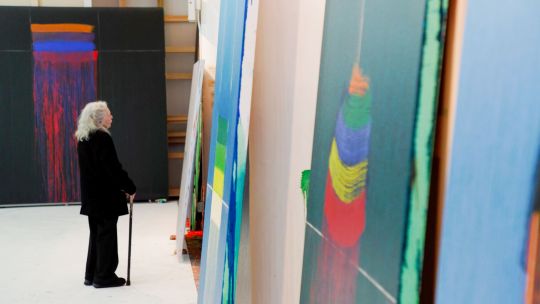
Pat Steir (American b. 1940). These astonishing new paintings are on view right now at Hauser & Wirth in West Hollywood, California. Steir has been painting thin veils of runny, cascading paint since the early 1990s. I'm amazed by the brilliant colors and sense of light in these most recent works. I recently included one of her paintings from twenty years earlier in this drip-themed post.
Friday Circus 2022-23. Oil on canvas, 84 x 54 inches.
Painted Rain #4 2022-23. Oil on canvas, 78 x 52 inches.
Garden 2022-23. Oil on canvas, 84 x 54 inches.
0 notes
Text


Two paintings by science fiction illustrator John Berkey (American 1932-2008). I don't have information as to the scale, materials, or original use of these pictures, though they were presumably intended for the covers of books. If space and science fiction art appeals to you, I highly recommend the Tumblr blog that originally hosted these images, retroscifiart.tumblr.com, as well as thevaultofretroscifi.tumblr.com.
0 notes
Text



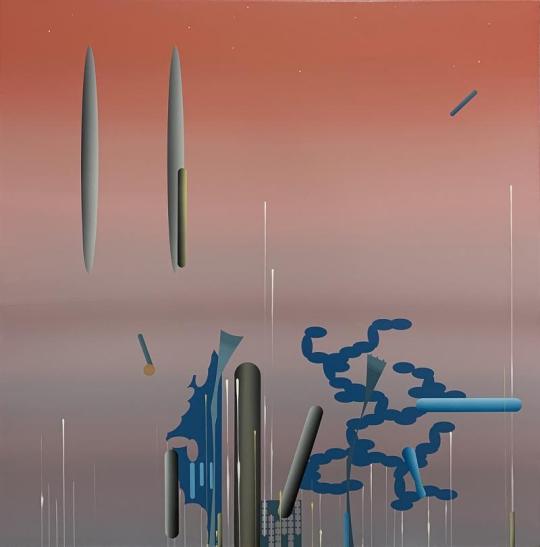



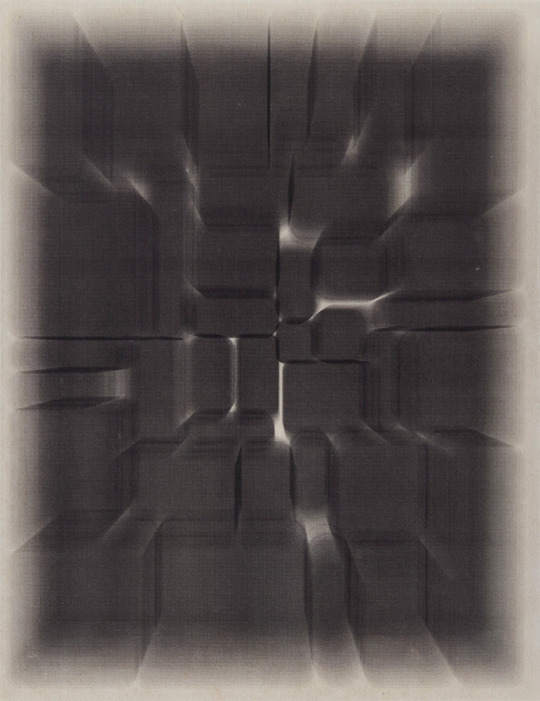
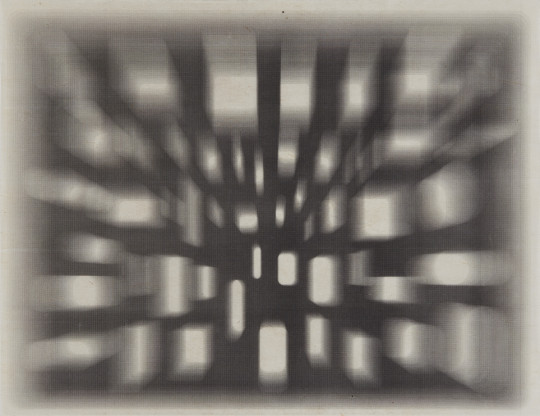
Three artists whose work evokes futuristic imagery. Tam Van Tran's detailed early paintings are reminiscent of glowing, digital schematics, while Adam Ross often references midcentury science fiction illustration. Marsh Cottrell uses a laser printer as an art-making tool, but these are not simply printouts of screen-based art; each of these works on paper is the result of the artist passing a sheet of paper through a laser printer multiple times, each time printing a slightly different image in pale gray until the all of the layers coalesce to describe a dark, mysterious space that wouldn't seem out of place in a film like Stanley Kubrick's 2001: A Space Odyssey.
Tam Van Tran (American, born Vietnam, 1966). Monticello 2000. Acrylic on canvas laid to panel, 30 x 64 inches. Source.
Heavy Metal from Greenland 2001. Acrylic on canvas, 79 x 67 1/2 inches. Source.
Hendryx on Aspirin 2002. Acrylic on canvas, 27 1/4 x 22 1/4 inches. Source.
Adam Ross (American b. 1962). Untitled (Chronopolis 2) 2003. Oil and alkyd on canvas over panel, size unknown. Source.
Until the End of the World #9 2016. Oil and alkyd on canvas, 48 x 36 inches.
Living in a Science Fictional World, #28 2021. Acrylic gouache on canvas over panel, 24 x 30 inches. Source.
Marsha Cottrell (American b. 1964). Aperture Series (40) 2016. Laser toner on paper, unique; 11 5/8 x 18 1/8 inches. Source.
Environments_14 2018. Laser toner on paper, unique; 11 x 8 1/2 inches. Source.
Environments_11 2018. Laser toner on paper, unique; 8 1/2 x 11 inches. Source.
0 notes
Text
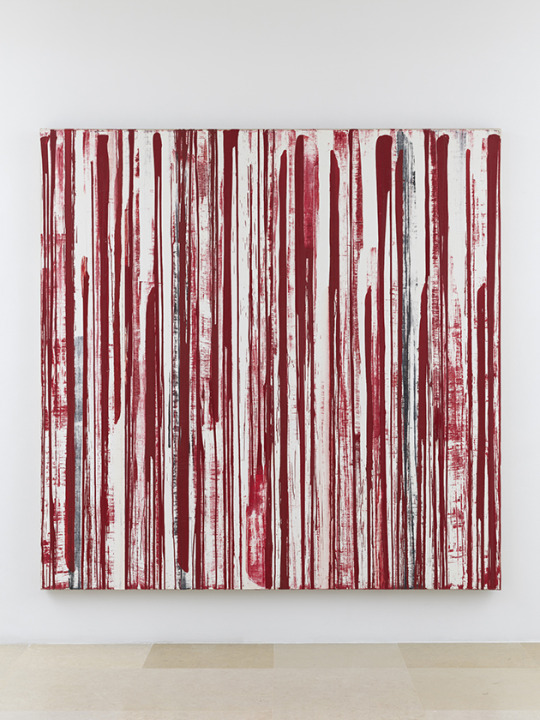



By chance I happened upon pictures of two nearly identical Jacqueline Humphries paintings, listed a few entries apart from one another on the "recent acquisitions" page of the LA MOCA website. It took me a moment to realize that one of the paintings was a mirror-image reproduction of the other. This reminded me of Robert Rauschenberg's similarly odd decision to make two copies of the same "combine," a type of painting/collage/sculpture hybrid he created in the 1950s. I'm not sure how Humphries executed her duplicate, which is made of a different type of paint than the original and is the tiniest bit off-scale (assuming Untitled #5 is the original and Untitled #5A is the duplicate).
Jacqueline Humphries (American b. 1960). Untitled #5 1995. Oil on linen, 90 x 90 inches. Museum of Contemporary Art, Los Angeles.
#5A 1995. Acrylic lacquer on canvas, 89 1/2 x 88 inches. Museum of Contemporary Art, Los Angeles.
Robert Rauschenberg (American b. 1925). Factum I 1957. Oil, ink, graphite, crayon, paper, fabric, newsprint, printed reproductions, and printed paper on canvas; 61 1/4 x 35 7/8 inches. Museum of Contemporary Art, Los Angeles. Source.
Factum II 1957. Oil, ink, graphite, crayon, paper, fabric, newsprint, printed reproductions, and printed paper on canvas; 61 3/8 x 35 3/4 inches. Museum of Modern art, New York. Source.
0 notes
Text






Raoul De Keyser (Belgian 1930-2012). Front 1992. Oil on canvas, 64 7/8 x 48 3/8 inches. Source.
Bern-Berlin hangend 1993. Oil on canvas, 33 3/8 x 47 1/4 inches. Source.
Avondversie 2003. Oil on canvas, 25 9/16 x 19 15/16 inches. Source.
Mary Heilmann (American b. 1940). Ming 1986. Acrylic and watercolor on canvas, 60 x 42 inches. Source.
The Passenger 1983. Oil on canvas, 98 x 78 inches. Source.
Neo Noir 1998. Oil and acrylic on canvas, 75 x 60 1/4 inches. Source.
Both of these painters produce spare, thinly-painted works that sometimes challenge our notion of what a finished painting looks like. The critic Raphael Rubenstein attempted to address this type of painting in a widely-read 2009 article titled "Provisional Painting."
0 notes
Text





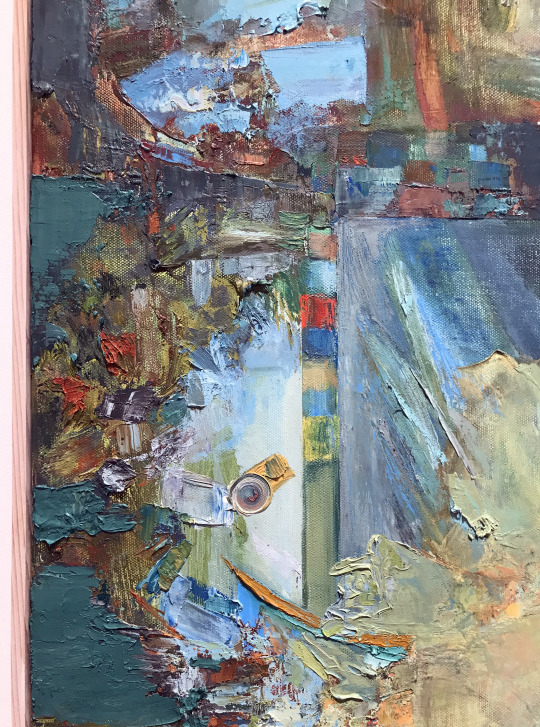

Last week I visited Drie Chapek's current exhibition at Greg Kucera Gallery. Though I was familiar with all of the paintings from images posted on the gallery website, I was, unsurprisingly, delighted to see the work up close, as reproductions of large-scale paintings cannot be expected to convey details such as the quality of the artist's individual marks. Chapek's gorgeous marks never seem forced, decorative, or showy; they have an organic quality, as if they spontaneously emerged from the surface of the canvas. This seems especially appropriate for an exhibition where the distinction between interior environments and the natural world appear to dissolve.
Drie Chapek (American b. 1979). Midday Living 2023. Oil and acrylic on canvas, 60 x 78 inches. Source.
Followed by six closeup images (not taken from Midday Living, however). You can see the entire exhibition here.
0 notes
Text




Eric Elliott (American). Floral studies Chris painted two weeks ago provided an opportunity to talk about edges in representational painting. Eric Elliott is a painter who explores the different ways solid objects can be perceived and rendered, and he often paints multiple iterations of each still-life arrangement. Accurately drawn lines establish the shape of the forms in the first image, giving it the appearance of a line-art illustration, while the second version, emphasizing light and atmosphere at the expense of clearly delineated boundaries, somehow feels more authentic to how we see.
Still Life in Pink and Orange 1 2022. Oil on canvas over panel, 10 x 12 inches.
Still Life in Pink and Orange 2 2022. Oil on canvas over panel, 10 x 12 inches.
Focus and Dissolve 2019-2020. Oil on canvas over panel; ten parts, 8 x 8 inches each.
Still Life with Blue Spray Bottle 1 2022. Oil on canvas over panel, 24 x 18 inches.
0 notes
Text



Ann Gale (American b. 1966). Eric Elliott studied with Ann Gale, another painter whose project is very much about perception. Compare her patchy, shimmering surface with the broken plane of a Cubist portrait. As I understand it, Gale's paintings are created during weeks or months of sittings, and the visual distortions and dislocations are the result of the artist faithfully observing changes and inconsistencies in the sitter's position and demeanor over time.
Gloria with Stripes 2020. Oil on canvas, 42 x 35 inches. Source.
Portrait with Glasses 2019. Oil on linen wrapped masonite, 14 x 11 inches. Source.
Pablo Picasso (Spanish 1881-1973). Portrait of Ambrose Vollard 1910. Oil on canvas, 36 1/4 x 25 5/8 inches. Pushkin State Museum of Fine Arts, Moscow.
0 notes
Text




Gerhard Richter (German b. 1932). Richter's practice of blurring edges is very different from the perception-based blurring of Eric Elliott and Ann Gale; for Richter, the point of the tactic seems to be disruption. Even his abstractions are scraped and dragged.
Hände 1963. Oil on canvas, in artist’s frame; 12 x 18 inches. Source.
Tisch (Table) 1963. Oil on canvas, 35 3/8 x 44 1/2 inches. Source.
S. mit Kind 1995. Oil on canvas, 16 x 14 1/4 inches. Hamburger Kunsthalle, Hamburg, Germany.
Forest (10) 2005. Oil on canvas, 77 5/8 x 52 inches. Museum of Modern Art, New York.
0 notes
Text
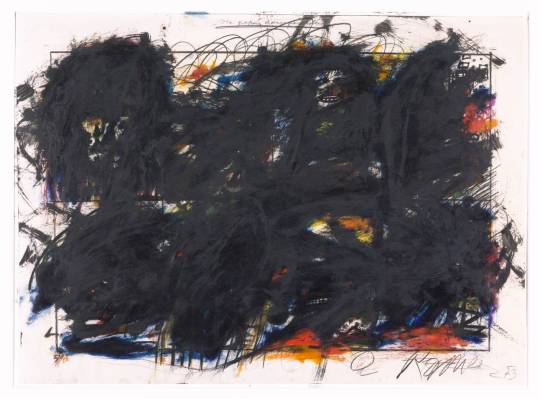

Arnulf Rainer (Austrian b. 1929). The Great Composers 1973. Lithograph with pastel and oil paint on paper, 17 x 23 inches. Tate, London.
Rita Ackermann (American, born Hungary, 1968). Mama, the Best is Always Yet to Come 2020. Oil, pigment, acrylic, china marker, and oil crayon on canvas; 75 x 65 inches. Source.
The visual disruptions in the Gerhard Richter paintings reminded me of these two artists, who paint or scribble over the top of photographs, prints, or drawings (in Ackermann's case).
0 notes
Text

Pablo Picasso (Spanish 1881-1973). Harlequin Paris, late 1915. Oil on canvas, 72 1/4 x 41 3/8 inches. Museum of Modern Art, New York.
Two weeks ago, in a conversation with Arianna, I tried to describe this work, in particular the presence of the peculiar rectangle--representing an unfinished painting--seen center-right, with its hasty brushwork, unpainted ground, and drips. The unpainted portion is generally understood to be the artist's self-portrait in silhouette.
0 notes
Text



Brice Marden (American 1938-2023). Complements 2004-2007. Oil on canvas; two parts, 72 x 96 inches overall. Source.
These closeup details came from an auction house listing of a lovely Brice Marden diptych. You can see the thinness of his richly colored paint, which has been partially scraped away with a painting knife. Many of the colored bands have a different color visible underneath, suggesting that he made many changes as he worked on this canvas over the course of three years.
0 notes
Text
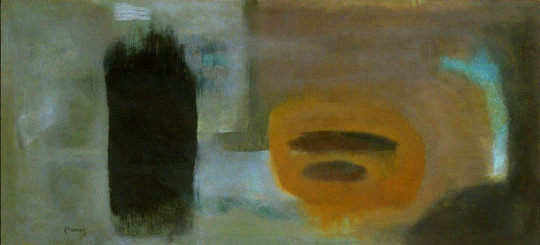
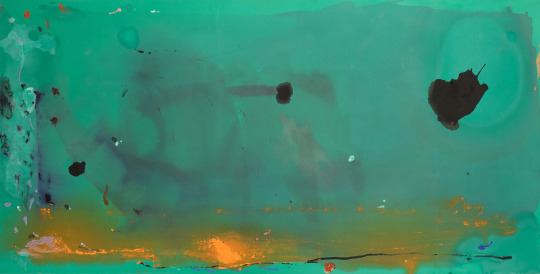






I selected these images in response to our discussion of Lyrical Abstraction, a somewhat ill-defined tendency in painting that historically followed Abstract Expressionism and coincided with (and shared artists with) Color Field. Art collector Larry Aldrich may have coined the term in a 1970 museum exhibition catalog essay, in which he suggested that the painters of the moment were moving away from "the geometric, hard-edge, and minimal, toward more lyrical, sensuous, romantic abstractions in colors which were softer and more vibrant." (Catalog PDF here.)
Theodoros Stamos, Helen Frankenthaler, and Philip Guston were Abstract Expressionist painters. With the occasional exception of Frankenthaler, they are not often described as being Lyrical Abstractionists, but I think these works fit the definition. Pat Lipsky, John Torreano, Judith Dolnick, and Robert Natkin are often placed into the category; Lipsky and Torreano had work in the above-mentioned exhibition. Howard Hodgkin's paintings often seem to have those qualities, but I've never seen the term applied to his work.
Theodoros Stamos (American 1922-1997). The Nest 1949. Oil on board, 22 x 47 5/8 inches. University of Michigan Museum of Art, Ann Arbor, Michigan.
Helen Frankenthaler (American 1928-2011). Madame Matisse 1983. Acrylic on canvas, 60 x 122 inches.
Philip Guston (American 1913-1980). To B.W.T. 1952. Oil on canvas, 48 1/2 x 51 1/2 inches. Seattle Art Museum. Source.
Pat Lipsky (American b. 1941). Zeus 1969. Acrylic on canvas, 44 x 55 1/2 inches. Brooklyn Museum, New York.
John Torreano (American b. 1941). Untitled 1969. Acrylic on canvas, 81 x 70 1/2 inches. Marjorie Barrick Museum of Art, University of Nevada, Las Vegas.
Judith Dolnick (American b. 1934). Untitled (526C) c. 1989. Acrylic on canvas, 48 x 48 inches. Source.
Robert Natkin (American 1930-2010). Bern Series 1986. Acrylic on canvas, 26 5/8 x 39 5/8 inches. Source.
Howard Hodgkin (British 1932-2017). Indoor Games 2016-17. Oil on wood, 29 x 38 inches. Source.
1 note
·
View note
Text
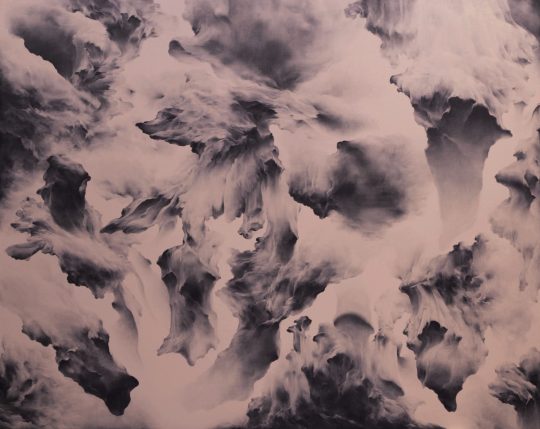



Moon Beom (Korean b. 1955). I shared these images with Nikki, but I think Moon Beom's paintings might appeal to several of the artists in our group. From what I understand, the artist lays down a solid, flat, colored ground in acrylic, and then makes marks in a contrasting color using oil stick. He then uses his finger to smudge the workable oil stick marks, creating the cloud-like forms you see here. The smudged oil stick dries like oil paint. The final image shows more detail; you can more clearly see the quality of the smudges and weave of the canvas.
Secret Garden #309 2012. Acrylic and oil stick on canvas, 71 5/8 x 89 3/4 inches. Source.
Possible worlds #846 c. 2010. Acrylic, oilstick, color pencil, and pen on canvas; 57 x 44 inches. Source.
Slow Same 840 c. 1990s. Acrylic and oil stick on canvas, size unavailable. Source.
Secret Garden #702 2013. Acrylic and oil stick on canvas, 24 x 19 inches. Source.
4 notes
·
View notes
Text



Pages from the Voynich manuscript, 15th or 16th century; author unknown. Beinecke Rare Book & Manuscript Library, Yale University, New Haven, Connecticut.
I was looking at Sana's new paintings, which couple floral imagery with geometric abstraction. I was particularly interested in the fact that the flowers she's painting are made-up: they combine qualities of different, unrelated plants. Invented flowers are common in visual art, beginning with the art of children, for whom drawing a daisy-like shape with wildly varying numbers of petals and colors produces an instantly recognizable representation of a blossom.
Sana shared with me images from the strange and fascinating Voynich manuscript, a mysterious illustrated codex containing illustrations of fanciful plants, among other things, along with as-yet undeciphered text written in an unknown script.
The next few posts will feature other examples of invented flora (and also mechanical objects) in art.
1 note
·
View note
Text
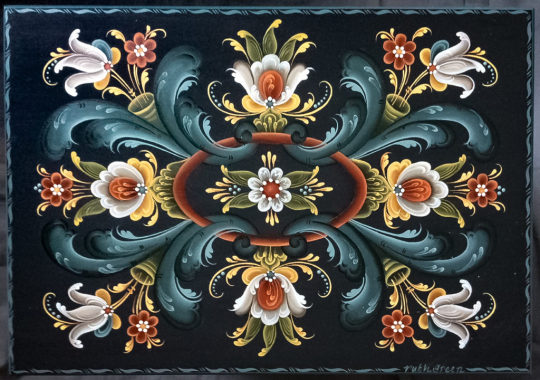
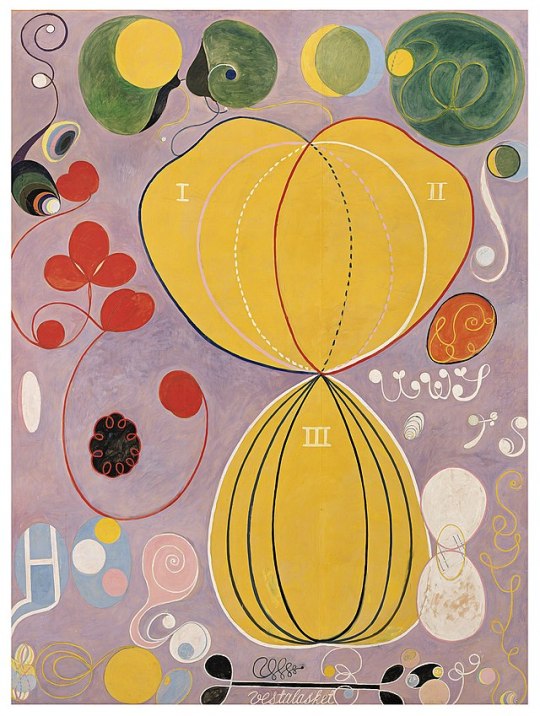


Folk art and textile designs commonly contain invented floral imagery; Norwegian Rosemåling patterns, for example, which are painted using a brush loaded with multiple shades of a color, blended on the brush to produce a single-stroke gradient.
Hilma af Klint was a visionary artist whose esoteric imagery reflected her involvement with spiritism; she also practically invented abstract painting. The very large, diagrammatic painting seen here contains plant- or flower-like elements, seemingly drawn from decorative art. There is a strong Surrealist element in the images of Louise Bourgeois. Orion Martin adopts a similar tendency, but adds a Pop/graphic art sheen to his polished, bizarre image.
Ruth Green (American b. 1943). Chest with Rosemåling in the American Rogaland style, 21st century. Source.
Hilma af Klint (Swedish 1862-1944). The Ten Largest, group IV, Adulthood 1907. Tempera and oil on paper, 129 x 94 1/2 inches. Hilma af Klint Foundation, Stockholm, Sweden.
Louise Bourgeois (American, born France, 1911-2010). Untitled 1997. Watercolor, ink, pencil and opaque white on paper; 15 x 11 1/4 inches. Source.
Orion Martin (American b. 1988). Floupe Resorte 2015. Oil on canvas, dimensions unknown. Source.
2 notes
·
View notes
Text
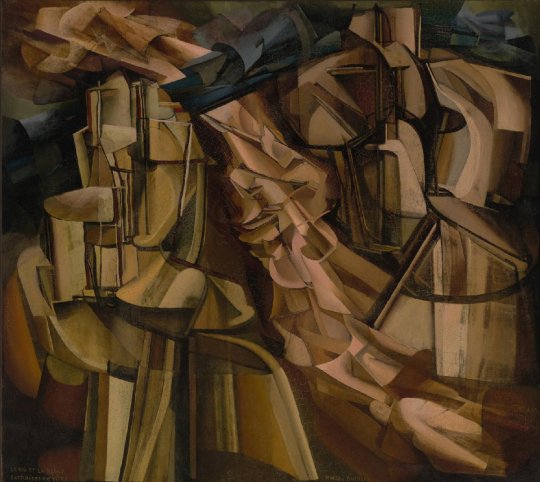

Invented forms are everywhere in Dada and Surrealist art; these examples use machine imagery in place of the flowers we are considering today. Marcel Duchamp's idiosyncratic take on Cubism combined organic and machine-like forms, while Francis Picabia juxtaposed improbable mechanical devices with incongruous inscriptions.
Marcel Duchamp (American (born France) 1887–1968). The King and Queen Surrounded by Swift Nudes 1912. Oil on canvas, 45 x 50 3/4 inches. Philadelphia Museum of Art, Philadelphia, Pennsylvania.
Francis Picabia (French 1879-1953). Parade amoureuse (Amorous Parade) 1917. Oil, gesso, metallic pigment, gold leaf, pencil, and crayon on board; 38 x 29 inches. Source.
0 notes